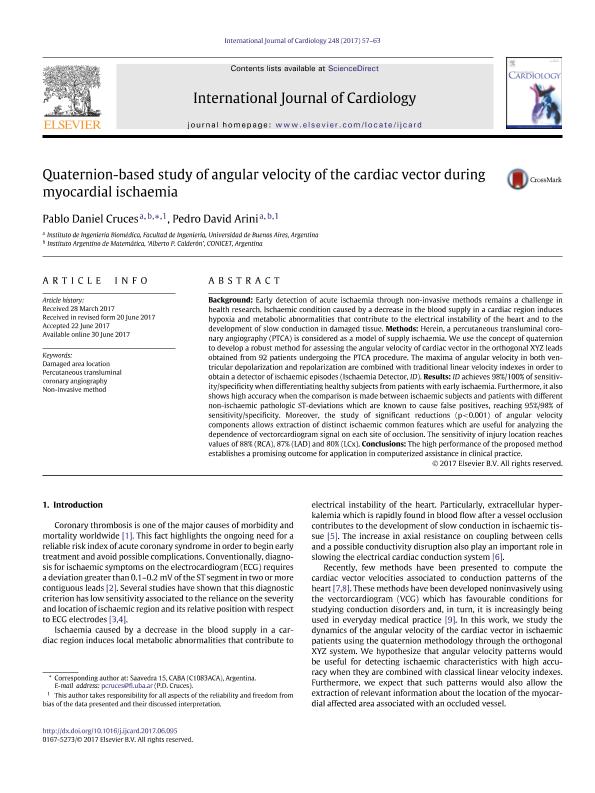Mostrar el registro sencillo del ítem
dc.contributor.author
Cruces, Pablo Daniel

dc.contributor.author
Arini, Pedro David

dc.date.available
2018-03-12T19:45:16Z
dc.date.issued
2017-12
dc.identifier.citation
Cruces, Pablo Daniel; Arini, Pedro David; Quaternion-based study of angular velocity of the cardiac vector during myocardial ischaemia; Elsevier Ireland; International Journal of Cardiology; 248; 12-2017; 57-63
dc.identifier.issn
0167-5273
dc.identifier.uri
http://hdl.handle.net/11336/38577
dc.description.abstract
Background: Early detection of acute ischaemia through non-invasive methods remains a challenge in health research. Ischaemic condition caused by a decrease in the blood supply in a cardiac region induces hypoxia and metabolic abnormalities that contribute to the electrical instability of the heart and to the development of slow conduction in damaged tissue. Methods: Herein, a percutaneous transluminal coronary angiography (PTCA) is considered as a model of supply ischaemia. We use the concept of quaternion to develop a robust method for assessing the angular velocity of cardiac vector in the orthogonal XYZ leads obtained from 92 patients undergoing the PTCA procedure. The maxima of angular velocity in both ventricular depolarization and repolarization are combined with traditional linear velocity indexes in order to obtain a detector of ischaemic episodes (Ischaemia Detector, ID). Results: ID achieves 98%/100% of sensitivity/specificity when differentiating healthy subjects from patients with early ischaemia. Furthermore, it also shows high accuracy when the comparison is made between ischaemic subjects and patients with different non-ischaemic pathologic ST-deviations which are known to cause false positives, reaching 95%/98% of sensitivity/specificity. Moreover, the study of significant reductions (p<0.001) of angular velocity components allows extraction of distinct ischaemic common features which are useful for analyzing the dependence of vectorcardiogram signal on each site of occlusion. The sensitivity of injury location reaches values of 88% (RCA), 87% (LAD) and 80% (LCx). Conclusions: The high performance of the proposed method establishes a promising outcome for application in computerized assistance in clinical practice.
dc.format
application/pdf
dc.language.iso
eng
dc.publisher
Elsevier Ireland

dc.rights
info:eu-repo/semantics/openAccess
dc.rights.uri
https://creativecommons.org/licenses/by-nc-nd/2.5/ar/
dc.subject
Damaged Area Location
dc.subject
Non-Invasive Method
dc.subject
Percutaneous Transluminal Coronary Angiography
dc.subject.classification
Ingeniería de Sistemas y Comunicaciones

dc.subject.classification
Ingeniería Eléctrica, Ingeniería Electrónica e Ingeniería de la Información

dc.subject.classification
INGENIERÍAS Y TECNOLOGÍAS

dc.title
Quaternion-based study of angular velocity of the cardiac vector during myocardial ischaemia
dc.type
info:eu-repo/semantics/article
dc.type
info:ar-repo/semantics/artículo
dc.type
info:eu-repo/semantics/publishedVersion
dc.date.updated
2018-03-12T19:29:32Z
dc.journal.volume
248
dc.journal.pagination
57-63
dc.journal.pais
Irlanda

dc.description.fil
Fil: Cruces, Pablo Daniel. Consejo Nacional de Investigaciones Científicas y Técnicas. Oficina de Coordinación Administrativa Saavedra 15. Instituto Argentino de Matemática Alberto Calderón; Argentina. Universidad de Buenos Aires. Facultad de Ingenieria. Instituto de Ingeniería Biomédica; Argentina
dc.description.fil
Fil: Arini, Pedro David. Consejo Nacional de Investigaciones Científicas y Técnicas. Oficina de Coordinación Administrativa Saavedra 15. Instituto Argentino de Matemática Alberto Calderón; Argentina. Universidad de Buenos Aires. Facultad de Ingenieria. Instituto de Ingeniería Biomédica; Argentina
dc.journal.title
International Journal of Cardiology

dc.relation.alternativeid
info:eu-repo/semantics/altIdentifier/doi/http://dx.doi.org/10.1016/j.ijcard.2017.06.095
dc.relation.alternativeid
info:eu-repo/semantics/altIdentifier/url/https://www.sciencedirect.com/science/article/pii/S0167527317319897
Archivos asociados
